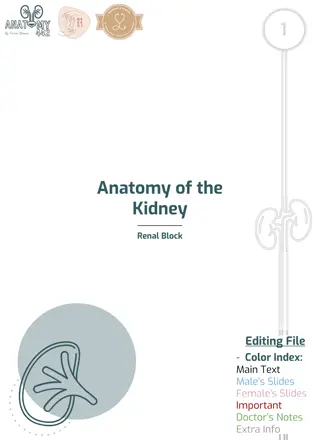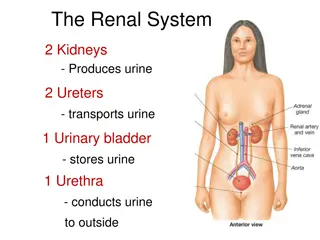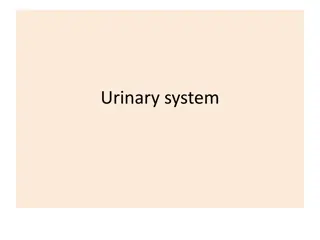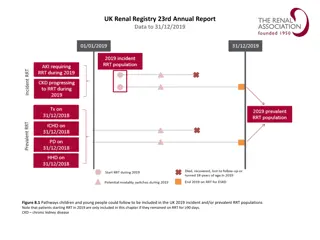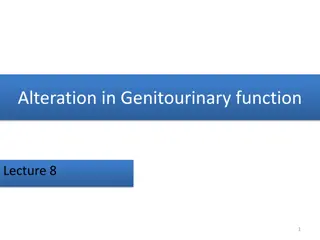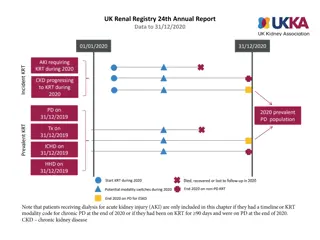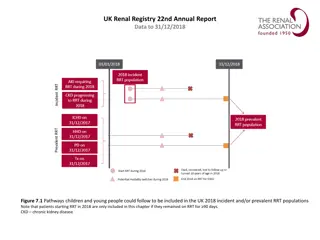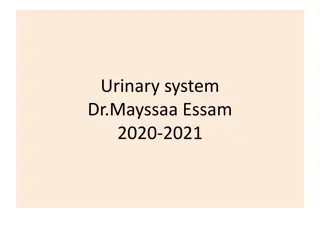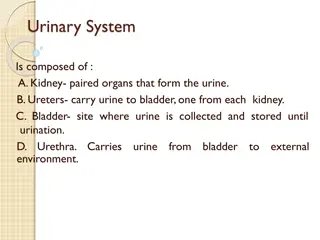Understanding Renal Physiology: The Role of the Kidneys in Maintaining Homeostasis
The urinary system consists of the kidneys, ureters, urinary bladder, and urethra, playing a crucial role in regulating blood volume, ion concentration, and pH. The kidneys, as the major excretory organ, remove metabolic waste products and help maintain water-electrolyte balance, regulate arterial pressure, acid-base balance, erythrocyte production, and more. Renal function involves glomerular filtration, tubular reabsorption and secretion, ultimately producing urine. Explore the anatomy and functions of the kidneys to understand their essential role in overall health.
Download Presentation

Please find below an Image/Link to download the presentation.
The content on the website is provided AS IS for your information and personal use only. It may not be sold, licensed, or shared on other websites without obtaining consent from the author. Download presentation by click this link. If you encounter any issues during the download, it is possible that the publisher has removed the file from their server.
E N D
Presentation Transcript
Renal Physiology The urinary system is composed of two kidneys, two ureter, urinary bladder, and urethra. The kidney plays a major role in controlling the volume of blood (water) and also controlling ion concentration and PH. It is the major excretory organ, responsible for the removal of metabolic waste products from the blood. The kidneys act on the plasma first converting it to ultra filtrate to which it later add and remove substances so that the final product is urine. The kidneys have several functions, including the following:
1 - Kidneys regulate water and electrolytes balance: If intake is less than excretion, the amount of that substance in the body will decrease, and vice versa. 2 - Kidneys responsible for excretion of metabolic waste products like urea from the metabolism of amino acids, creatinine from muscle creatine, uric acid from nucleic acid, bilirubin the end product of Hb breakdown, metabolites of various hormones and foreign chemicals like drugs and toxins. Hormones in the blood are removed in many ways, mostly in the liver, but a number of hormones are removed in parallel by renal processes. The level of nitrogenous waste in the blood is typically expressed as blood urea nitrogen (BUN). The urea concentration is normally 7-18 mg/dL. An abnormally elevated BUN is called azotemia and may indicate renal insufficiency. (See the notes below).
3 -Kidneys play essential role in regulation of arterial pressure both in long-term regulation (through excretion of variable amounts of sodium and water) and in short-term regulation (through secretion of vasoactive factors or substances such as renin). 4 -Kidneys contribute to acid-base regulation (along with the lungs and body buffers) through excreting acids and by regulating the body buffer stores. 5 -Kidneys responsible for regulation of erythrocyte production from the bone marrow by secreting erythropoietin which stimulate the bone marrow to produce erythrocytes. 6 -Kidneys regulate 1,25-dihydroxy vit. D3production which is essential in regulation of Ca and phosphate. 7 -In kidneys, gluconeogenesis can take place. Most gluco- neogenesis occurs in the liver, but a substantial fraction occurs in the kidneys, particularly during a prolonged fast.
Anatomy and function of the kidney Renal function is based on four steps: 1 - Glomeruli form ultrafiltrate, which flows into renal tubules. 2 and 3 - Tubules reabsorb and secrete solute and water from the ultrafiltrate. 4 - Tubular fluid leaves the kidney via the ureter to the bladder and out through the urethra. Blood from renal arteries is delivered to the glomeruli. At one fifth of cardiac output, this is the highest tissue-specific blood flow.
The kidney: The kidney divided into cortex and medulla, and composed of: [1] Nephron, [2] Blood vessels and [3] Nerves. [1] The Nephron: It is a tubular system, and it is the basic functional unit of the kidney that capable of forming urine by itself. There are about 1.3 million nephrons in each kidney in human. Kidneys cannot regenerate new nephrons and their number decrease with aging. Each nephron consists of:
A - Bowmans capsule: It is the invaginated blind end of the tubule that encased the glomerulus (200 m in diameter and is formed by the invagination of a tuft of capillaries into the dilated blind end of the nephron). The pressure in the glomerular capillaries is higher than that in other capillary beds. The membrane of the glomerular capillaries is called the glomerular membrane. The average total area of each glomerulus is about 0.4 mm2, and the total area of glomerular capillary endothelium across which filtration occurs (i.e. the glomerular membrane) is about 0.8m2. In general, this membrane is different from other capillary membranes by having three layers instead of two. These three layers are endothelial layer of the capillary itself, a basement membrane (basal lamina), and a layer of epithelial cells (podocytes) (As in the figure).
Another type of cells is also present between the basal lamina and the endothelium called mesangial cells, which are contractile cells and play a role in the regulation of glomerular filtration besides other functions. Yet, despite the number of layers, the permeability of the glomerular membrane is from 100-500 times as great as that of the usual capillary. The tremendous permeability of the glomerular membrane is caused by: 1 - The presence of thousands of small holes which are called fenestrae in the endothelial cells. 2 - The presence of large spaces in the basement membrane. 3 - Incontinuity of the cells that form the epithelial layer which are finger-like projections that forms slits between themselves called slit-pores (filtration slits).
B - The Tubule: Throughout its course, the tubule is made up of a single layer of epithelial cells resting on a basement membrane. (Note: All epithelial cell layers rest on a basement membrane). The structural and immunocytochemical characteristics of these epithelial cells vary from segment to segment of the tubule. A common feature is the presence of tight junctions between adjacent cells that physically link them together. The tubule divided in: 1 - Proximal tubules: It includes proximal convoluted tubule and proximal straight tubule. They lie in the renal cortex along with the glomerulus. The epithelial cells of the proximal tubule are highly metabolic cells, with large number of mitochondria to support extremely rapid active transport processes and they are interdigitated with one another and are united by apical tight junction but contain lateral intercellular space. It contains a brush border due to the presence of microvilli. Reabsorption in the proximal tubule is essentially isotonic; i.e. the osmolality of fluid in all parts of the proximal tubule is approximately to that of plasma.
2 - Loops of Henle: The nephrons with their glomeruli located in the outer portion of the renal cortex have short loops of Henle (cortical nephrons, 70%), where as those with glomeruli in the juxtamedullary region of the cortex (juxtamedullary nephrons, 30%) have long loop extending down into medullary pyramids. Loops of Henle include: The thin descending segment, the thin ascending segment, and the thick ascending segment. The thin descending segmentof the loop of Henle: The epithelia cells of it are very thin with no brush border and very few mitochondria. They are highly permeable to water but nearly impermeable to urea, sodium and most other ions. About 20% of the filtered water is reabsorbed in the descending thin limb loop of Henle The thin ascending segmentof the loop of Henle: The epithelia cells of the ascending thin segment, on the other hand, are far less permeable to water but more permeable to urea and NaCl than is the descending portion. Because of the ascending thin limb is impermeable to water, no water reabsorption is taking place in this area of the nephron.
The thick ascending segmentof the loop of Henle: The epithelial cells of the ascending thick segment are similar to those of the proximal tubules except that they have a rudimentary brush border and much tighter tight junction. The cells adapted for strong active transport of Na, K, and Cl ions. On the other hand, the thick segment is almost entirely impermeable to both water and urea. Therefore, no water reabsorption is taking place in this area of the nephron, and this segment is called the diluting segment. It is the only segment in which active Cl pumping normally occur. This active transport of ions can be inhibited by drugs called loop diuretics such as frusemide, ethacrynic acid, and bumetanide, which consequently abolish the intraluminal positivity. Eventually the passive absorption of Na ions ceases.
This thick ascending segment ascends all the way back to the same glomerulus from which the tubule originated and passes tightly through the angle between the afferent and efferent arterioles. The cells of this portion of the thick ascending segment, which are in complete attachment with the epithelial cells of the afferent and efferent arterioles, are called Macula densa. The specialized smooth muscle cells of the afferent arterioles that come in contact with the macula densa are called juxtaglomerular cells (JG cells) which contain renin granules. Macula densa and JG cells plus few granulated cells between them are collectively known as juxtaglomerular complex or apparatus which has a dense adrenergic neural innervation.
About 25% of filtered loads of Na, Cl, and K (and other ions such as Ca, HCO3-and Mg) are reabsorbed in the loop of Henle mainly in the thick ascending limb. Because the thick segment of the ascending loop impermeable to water, most of the water delivered to this segment remains in the tubule, despite the reabsorption of large amounts of solute. Thus, the tubular fluid in the ascending limb becomes very dilute as it flows toward the distal tubule (hypotonic). of Henle is
3 - Distal convoluted tubule: They lie in the renal cortex. The distal tubule (also called the diluting segment) has almost the same characteristics as the thick segment of ascending limb of the loop of Henle. It reabsorbs Na ions and other ions but is almost entirely impermeable to both water and urea. This segment is the site of action of special type of diuretics called thiazide and loop diuretics. Reabsorption of water can occurs in the distal tubule but only in the presence of antidiuretic hormone (ADH, or vasopressin). With high level of ADH, these tubular segments are permeable to water, but in the absence of ADH, they are virtually impermeable to water. Reabsorb Na ions while secrete K ions through increase the activity of Na-K ATPase countertransporter at the basolateral side of the cells under the effect of the hormone aldosterone. Reabsorb K ions while secrete H ions via H-K ATPase countertransporter at the luminal border of the cell. Secretion of H ions (by H-ATPase pump) at the luminal border of the cells after being generated inside the cell by the action of carbonic anhydrase on water and CO2 to form carbonic acid which then dissociates into H ions and HCO3- ions. Then the available HCO3- ions are reabsorbed across the basolateral membrane. Aldosterone also increases H ion secretion by stimulating the H-ATPase pump.
4 - Collecting tubules and ducts: About eight distal tubules coalesce (unit) to form the collecting tubule which turns once again away from the cortex and passes downward into medulla where it becomes the collecting ducts. The epithelium of collecting ducts is made up of principal cells (P cells) which are involved in Na ions reabsorbtion and vasopressin-stimulated water reabsorption and intercalated cells (I cells) which are concerned with acid secretion and bicarbonate transport.
[B] Blood vessels: The renal fraction of the total cardiac output is about 21% (vary from 12-30%). In resting adult, the blood flow in renal cortex is about 98% of the total renal blood flow while in medulla is only 2% of the total renal blood flow. This is why the O2 consumption of cortex is much higher than that of medulla. Arterial system of the kidney is technically a portal system, because branches twice in the following arrangement: Renal artery Segmantal artery Interlobar artery arcuate artery Interlobular artery Afferent arteriole branching capillaries in Bowman`s capsule (glomerulus) Efferent arterioles branching around the tubules so called (Peritubular capillaries) Venules Interlobular veins arcuate vein interlobar vein Renal veins. Most of the peritubular capillary network lies in the renal cortex alongside the proximal, distal, and collecting tubules.
In the juxtamedullary glomeruli, long efferent arterioles extend from the glomeruli down into the outer medulla and then divide into specialized long and straight capillary loops called vasa recta extended downward into the medulla to lie side by side with the lower parts of thin segments of juxtaglomerular loops of Henle all the way to the renal papillae. Then, like the loop of Henle, they also loop back toward the cortex and empty into the cortical veins. This specialized network of capillaries in the medulla plays an essential role in the formation of concentrated urine.
[C] Nerve supply: The kidney has a rich adrenergic sympathetic nerve supply distributed to the: 1 - Vascular smooth muscle to cause vasoconstriction. 2 - Juxtaglomerular cells to cause renin secretion. 3 - Tubular cells to stimulate Na and water reabsorption. There is no significant parasympathetic innervation
Glomerular function: Glomerular filtration rate (GFR): It is the fluid that filtrate through the glomerulus into Bowman`s capsule each minute in all nephrons of both kidneys which is about 125 ml/min or 180 L/day in males (10% lower in female). The high GFR of the glomerular membrane is due to very high permeability of the glomerulus capillaries, which is about 100-500 times as great as that of the usual capillary. Yet, despite the tremendous permeability of the glomerular membrane, it has an extremely high degree of selectivity. The selectivity of the glomerular membrane depends on: [1] Size of the molecules: Neutral substance with effective molecular diameter of less than 4 nm are freely filtrated, and those with diameter more than 8 nm (80 A), filtration is zero. Between these two values, filtration is inversely proportional with diameter.
[2] The electrical charges of the molecules: This is because the inner side of the pores of the glomerular membrane is negatively charged repelling other negatively charged molecules that tend to pass through pores. For these two reasons, the glomerular membrane is almost completely impermeable to all plasma proteins but is highly permeable to all other dissolved substances in normal plasma. The composition of the glomerular filtrate is the same as plasma except that it has no significant amount of proteins.
The filtration fraction is the fraction of the renal plasma flow that becomes glomerular filtrate. Since the normal plasma flow through both kidneys is 650 ml/min and the normal GFR is 125 ml/min, the average filtration fraction is about 1/5 or 19%.
Factors that affect GFR: GFR is determined by [1]the net filtration pressure and [2] the capillary filtration coefficient (Kf). GFR can be expressed mathematically as below: GFR = Kf X net filtration pressure Net filtration pressure = (Glomerular pressure + Colloid osmotic pressure in Bowman s capsule) - (Capsular pressure + Colloid osmotic pressure of the glomerular capillaries) [1]The net filtration pressure: Is the net pressure forcing fluid through glomerular membrane (the Starling forces) which is determined by: A- Glomerular capillary hydrostatic pressure: This can be affected by several factors:
1 - Renal blood flow: Increase blood flow through the nephrons greatly increases the GFR for two reasons: (A) The increasing flow increases the glomerular pressure which enhances filtration. (B) The increased flow through the nephrons allows less time for plasma proteins to be more concentrated at the venous end of the glomerular capillaries bed. Therefore, far less inhibitory influence on glomerular filtration. 2 - Afferent arteriolar constriction: Leads to decrease the rate of blood flow into the glomeruli and also decrease the glomerular pressure and decrease the GFR, and vice versa. 3 - Efferent arteriolar constriction: A slight efferent arteriolar constriction increases the glomerular pressure causing slight increase in GFR. However, moderate and severe efferent arteriolar constriction causes a paradoxical decrease in the GFR despite the elevated glomerular pressure. This is due to the fact that plasma in this case will remain for long period of time in the glomerulus, and extra large portion of plasma will filter out. This will increase the plasma colloid osmotic pressure to excessive level causing a decrease in the GFR.
B - The change in Bowmans capsule hydrostatic pressure: Increasing the hydrostatic pressure in Bowman s capsule (as in urinary tract obstruction) reduces GFR and vice versa. C - The change in glomerular capillary colloid osmotic pressure: A decrease in the glomerular capillary colloid osmotic pressure increases GFR and vice versa. D - An increase in the Bowman s colloid osmotic pressure: This may occur in diseases that causes filtration of proteins across glomerular membrane and consequently increases GFR.
[2] The capillary filtration coefficient (Kf): Is the product of the permeability and filtering surface area of the capillaries. It can be affected by: A - The changes in the permeability of the glomerular capillaries, which may be changed in disease state with consequent changes in the GFR. B - The thickness and the surface area of the capillary bed across which filtration is taking place which can be changed with a consequent change in the GFR. An example of such change is contraction or relaxation of mesangial cells in response to various substances can induce a decrease or an increase in the effective filtration surface area and eventual changes in the GFR.
In summary: GFR can be affected by: [1]: The filtration pressure, which is influenced by: A. Glomerular capillary hydrostatic pressure which is affected by: I. Renal blood flow. II. Afferent arteriolar constriction. III. Efferent arteriolar constriction. B. Bowman s capsule hydrostatic pressure. C. Glomerular capillary colloid osmotic pressure. D. Bowman s colloid osmotic pressure. [2]: The capillary filtration coefficient (Kf), which can be affected by: A. The permeability of the glomerular capillaries. B. The thickness and surface area of capillary bed.





